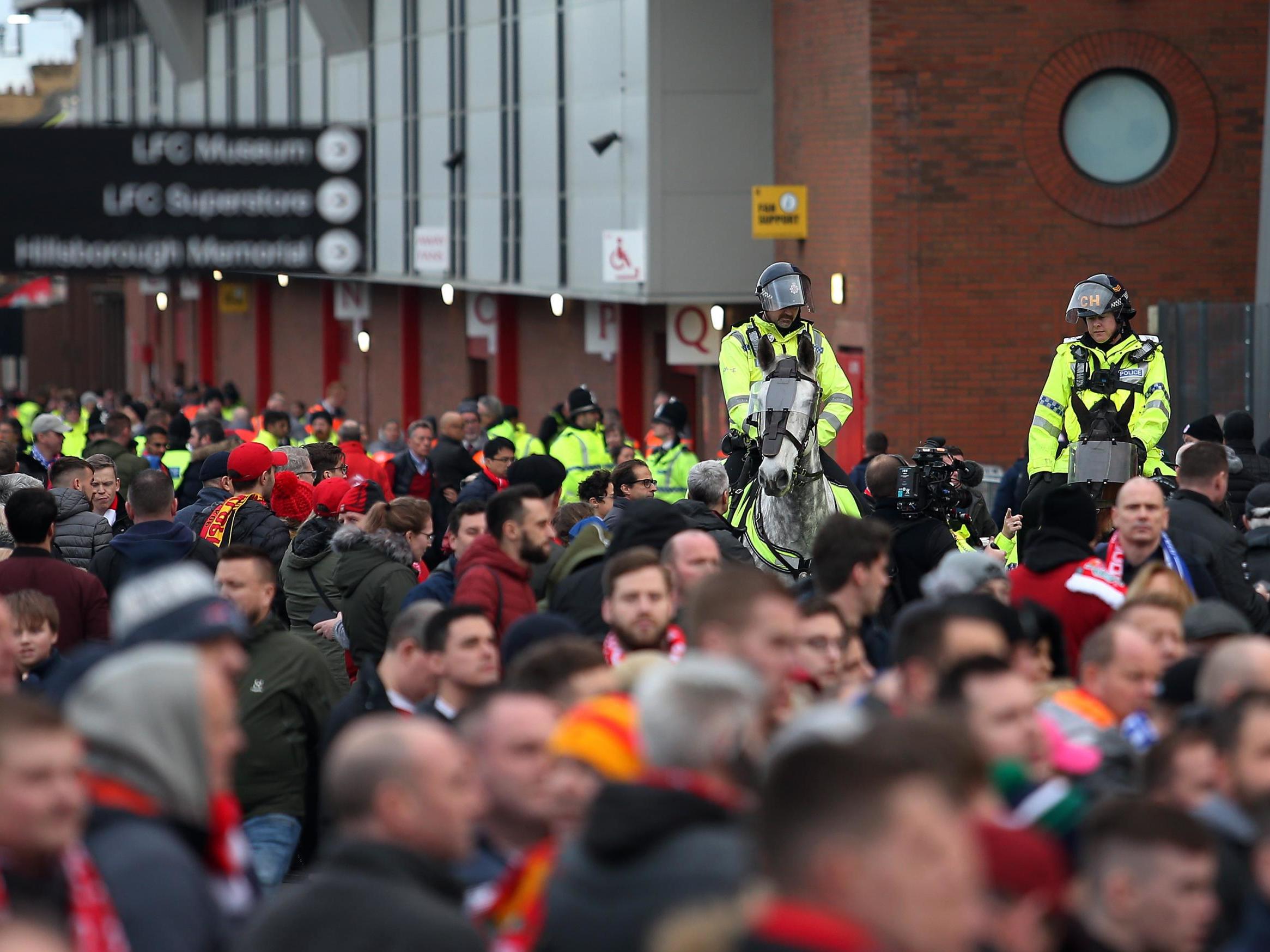Liverpool vs Everton and the slow death of a once friendly derby
Worrying developments provided depressing evidence that the mood of the rivalry is becoming more fractious

The friendly derby isn’t quite dead but the relationship between Everton and Liverpool fans gets less genial by the year. Events at the weekend’s FA Cup third-round tie at Anfield provided depressing evidence that the mood around the game is becoming more fractious.
Merseyside Police went to huge lengths to separate the two sets of fans before and after the match. The authorities closed Anfield Road, which meant shutting a fan zone and moving the Fans Supporting Food Banks van that does such effective work on match days from its usual position. This is important because efforts to alleviate poverty have been a huge unifying factor for supporters.
The away fans were penned outside the stadium pre- and post-game, creating unpleasant conditions and much anger. A dispersal zone was put in place, giving police the power to instruct individuals to leave the area if officers believed they were causing “harassment, alarm or distress” to the public. The Spirit of Shankly and Blue Union supporters’ groups were not consulted and the changes to the methods of policing caused widespread dismay. A joint statement from the fans’ organisations called the restrictions “heavy-handed, disproportionate and out of touch with the reality of the overwhelming majority of Liverpool and Everton match going fans” and expressed concerns about the precedents set for future meetings between the teams.
Inside the ground, there were also worrying developments. The majority of Everton fans turned their back to the pitch during You’ll Never Walk Alone. On the face of it, this means little, a mere show of disdain for Anfield’s overhyped anthem. In reality, it evoked darker undercurrents.
In 2005, a large number of Juventus fans showed their contempt for Liverpool’s attempt to express contrition for the Heysel stadium disaster by turning away from the Kop when a mosaic with the word ‘Amiciza’ – friendship – was displayed. They repeated the gesture during the minute’s silence for the 39 people who died in Brussels in 1985. The sight of a Juventus flag in the visiting fans' section on Sunday tells its own story.
Heysel is the faultline between the two sets of fans on Merseyside. Pictures emerged on social media after Sunday’s game of Everton supporters making what have become known as ‘wall-pushing’ motions – most of the deaths at Heysel occurred after a wall collapsed – and chants of “murderers” are commonly sung by a minority of Evertonians.
It is not one-sided nastiness. There is a long history of Liverpool fans trivialising Heysel and some still refuse to accept any culpability for the horrific night in Brussels. A banner that says ‘Steaua Bucharest 1986’ has been a frequent sight on the Kop. The Romanian side won the European Cup 12 months after the disaster in Belgium. Everton, as English champions, would have been among the favourites to win the competition but Howard Kendall’s great side were not to allowed to take part because of the post-Heysel ban.
Everton have been in decline since the 1980s and the aftereffects of Heysel contributed to that downturn in fortunes - but only to the smallest degree. The vast majority of the club’s problems have been self-inflicted. Unfortunately, a generation of Evertonians – many who were not even born 35 years ago – have grown up to believe that the nightmare in Brussels was a watershed for the club.

It is a small but angry minority but their beliefs have a pernicious effect on the mood at derbies, even if the support from Goodison for the campaigns for justice over Hillsborough has been unstinting and deserves all the praise that has been directed at the club and supporters.
Any formalisation of segregation outside the ground will only serve to make matters worse. The real turning point in the rivalry was in 1994 when Anfield and Goodison became all-seater stadiums. Before then, most sections of the terraces were mixed during derbies. The main stand side of the standing Kop was colonised by thousands of Evertonians and hordes of reds acquired tickets for the Gwladys Street end for the reverse fixture. The us-and-them mentality has grown stronger in designated sections where interaction with opposition fans is minimised. It makes extreme behaviour easier. The Blue Union and Spirit of Shankly are right to worry about the future and the precedents generated by draconian policing.
It is important not to mythologise the past. There were always a small number of vicious spats inside the grounds at derbies and the city centre was never a place for the faint-hearted on nights when Liverpool and Everton had met. But the unpleasantness rarely equalled the levels of, say, a north London or Manchester derby. These days, however, there are fewer and fewer reasons to eulogise behaviour on Merseyside. The friendly derby was never quite as affable as many people believed and the future will likely be even more spiteful.
Join our commenting forum
Join thought-provoking conversations, follow other Independent readers and see their replies
Comments